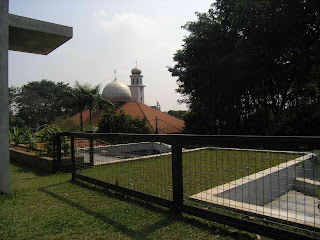Greening roofs: A simple way to reduce global warming
Was published in Jakarta Post on Sunday, September 23, 2007
 One of the reasons why the people of
One of the reasons why the people of
Back then, the general assumption was a house would not be complete without the grass next to it.
Such an ideal has lost its priority.
Re-urbanization in the past few years has gained its momentum concurrent with the erection of new apartment buildings in the heart of
The price of land has risen drastically and the city's density is higher than ever before. Nowadays, people are more willing to live in much smaller lots. However, this paradigm shift has not been followed by a small-living mentality, which means living more efficiently and optimizing space usage.
People tend to maximize their homes within the lots and without a choice, leaving no space for greenery.
 Many homes are still built in a traditional manner, as if
Many homes are still built in a traditional manner, as if
The house offers more green space than any other conventional urban home. It does not utilize a traditional pitched-roof design; rather it has specifically been designed to have a green roof.
Designed by Adi Purnomo, a Jakarta-based contemporary architect known for his environmentally conscious approach, the house has changed the perception of how houses in urban settings should be designed.
*****
A green roof does not simply refer to color of the roof. It is a roof that is partially or completely covered with vegetation and soil, or a growing medium, planted over a waterproofing membrane.
Green roofs gained popularity in North America in the last few years, although they are not as common as in
 One benefit is that a green roof helps to reduce the urban heat island effect, where a certain area in an urban setting is significantly warmer than its surroundings.
One benefit is that a green roof helps to reduce the urban heat island effect, where a certain area in an urban setting is significantly warmer than its surroundings.
The United States Environmental Protection Agency (EPA) explains that when vegetation is replaced by asphalt and concrete for roads, buildings and other structures necessary to accommodate a growing population, these surfaces absorb the sun's heat, causing surface temperatures and overall ambient temperatures to rise.
Another benefit of green roofs is a physical phenomenon known as evaporative cooling. The rainwater retained by green roofs generates the water evaporation process within the roof's layer. This process cools the roof and significantly contributes to lessen the energy used in air conditioning.
*****
The scarcity of green space in
The house on Jl. Tangkuban Perahu does not merely convert the traditional flat roof into a green roof, but also proposes a new approach for an urban house garden.
The green roof on this house serves as stacked landscape and changes the perception of a multistory home as each room in the house has the luxury of facing at least some greenery.
However, the application of a green roof does not come without challenges. Technically, green roofs require more structural consideration than conventional roofs to accommodate the extra weight from the amount of soil and water they retain. The roof has to be deep enough to allow vegetation to grow depending on the type of plants it uses.
The other hindrance is more cultural than physical. In some beliefs, the idea of living underneath the soil is viewed as being buried under the ground, as in a graveyard; a feature that is undesirable for a house.
Ultimately, having a green roof on top of your house is one of many things we can do to upgrade our living quality in
Similar to increasingly popular hybrid cars, green roofs should be viewed as next-generation luxury features, rather than Italian marble or classical columns.
All images are courtesy of Adi Purnomo

0 Comments:
Post a Comment
Subscribe to Post Comments [Atom]
<< Home